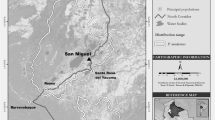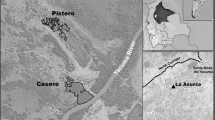My objective is to better understand the influences of seasonality and frugivory on ranging patterns for 3 guenon species of the Taï Forest: Cercopithecus campbelli, C. petaurista, and C. diana). Over a 17-mo period, I gathered data on the daily path length, home range size, and home range use for 2 habituated groups of each species. The ranging patterns of the 3 species were very similar to each other and across seasons. Further, the ranging patterns were not closely related to fruit abundance or consumption. Each species had a long-ranging strategy with long daily ranges relative to home range size and little repeated use of areas on successive days, which may relate to territory and boundary patrols, especially for Cercopithecus diana. I compare them with other guenon communities and demonstrate that the ranging patterns of the 3 species are more similar than the ranging patterns of sympatric guenons in other communities. I discuss the results in relation to the association of Cercopithecus campbelli and C. petaurista with C. diana for antipredator benefits.

Similar content being viewed by others
REFERENCES
Botero, P. (2002). Is the white-flanked antwren (Formicariidae: Myrmotherula axillaris) a nuclear species in mixed flocks? A field experiment. J. Field Ornithol. 73: 74–81.
Bshary, R., and Noë, R. (1997). Red colobus and Diana monkeys provide mutual protection against predators. Anim. Behav. 54: 1461–1474.
Butynski, T. (1990). Comparative ecology of blue monkeys (Cercopithecus mitis) in high and low density subpopulations. Ecol. Monogr. 60: 1–26.
Buzzard, P. J. (2004). Interspecific Competition Among Cercopithecus campbelli, C. petaurista, and C. diana at Taï Forest, Côte d’Ivoire. Ph.D. dissertation, Columbia University, New York.
Buzzard, P. J., and Eckardt, W. (in press). Social systems of the Taï guenons. In Noë, R., McGraw, W. S., and Zuberbühler, K. (eds.) Monkeys of the Taï Forest: A African Primate Community, Cambridge University Press, Cambridge.
Chapman, C. A., Chapman, L. J., Cords, M., Gathua, M., Gautier-Hion, A., Lambert, J. E., Rode, K., Tutin, C. E. G., and White, L. J. T. (2002). Variation in the diets of Cercopithecus species: Intraspecific differences within forests, among forests, and across species. In Glenn, M. E., and Cords, M. (eds.), The Guenons: Diversity and Adaptation in African Monkeys, Kluwer Academic, New York, pp. 325–350.
Cords, M. (1987). Mixed species associations of Cercopithecus monkeys in the Kakamega Forest. Univ. Ca. Publ. Zoo. 117: 1–109.
Cords, M. (2002). Friendship among adult blue monkeys (Cercopithecus mitis). Behaviour 139: 291–314.
Demment, M. W., and Laca, E. A. (1991). Herbivory: The dilemma of foraging in a spatially heterogenous food environment. In Palo, R. T., and Robbins, C. T. (eds.), Plant Defenses Against Mammalian Herbivory, CRC Press, Boca Raton, FL, pp. 29–44.
Dunbar, R. I. M. (1987). Habitat quality, population dynamics, and group composition in colobus monkeys (Colobus guereza). Int. J. Primatol. 8: 299–329.
Fashing, P. J. (2001). Activity and ranging patterns of guereza. Int. J. Primatol. 22: 549–578.
Fashing, P. J., and Cords, M. (2000). Diurnal primate densities and biomass in the Kakamega Forest: An evaluation of census methods and a comparison with other forests. Am. J. Primatol. 50: 139–152.
Garber, P. A. (1993). Seasonal patterns of diet and ranging in two species of tamarin monkeys: Stability vs. variability. Int. J. Primatol. 14: 145–166.
Gautier-Hion, A., Quris, R., and Gautier, J.-P. (1983). Monospecific vs. polyspecific life: A comparative sudy of foraging and antipredatory tactics in a community of Cercopithecus monkeys. Behav. Ecol. Sociobiol. 12: 325–335.
Goodall, J. (1986). The Chimpanzees of Gombe: Patterns of Behavior, Harvard University Press, Cambridge.
Hill, C. M. (1994). The role of female diana monkeys (Cercopithecus diana) in territorial defense. Anim. Behav. 47: 425–431.
Höner, O. P., Leymann, L., and Noë, R. (1997). Dyadic associations of red colobus (Colobus badius) and the Diana monkey (Cercopithecus diana) groups in the Taï National Park, Ivory Coast. Primates 38(3): 281–291.
Janson, C. H., and Chapman, C. A. (1999). Resources and primate community structure. In Fleagle, J. G., Janson, C. H., and Reed, K. E. (eds.), Primate Communities, Cambridge University Press, Cambridge, pp. 237–261.
Janson, C. H., and Goldsmith, M. L. (1995). Predicting group size in primates: Foraging costs and predation risks. Behav. Ecol. Sociobiol 6: 326–336.
Kaplin, B. A. (2001). Ranging behavior of two species of guenons (Cercopithecus lhoesti and C. mitis doggetti) in the Nyungwe Forest Reserve, Rwanda. Int. J. Primatol. 22: 521–548.
Korstjens, A. H. (2001). The Mob, the Secret Sorority, and the Phantoms: An Analysis of the Socio-ecological Strategies of the Three Colobines of Taï, Unpublished Ph.D. thesis Utrecht University, The Netherlands.
Lambert, J. (2002). Resource switching and species coexistence in guenons: A community analysis of dietary flexibility. In Glenn, M. E., and Cords, M. (eds.), The Guenons: Diversity and Adaptation in African Monkeys, Kluwer Academic, New York, pp. 309–324.
Lowen, C., and Dunbar, R. I. M. (1994). Territory size and defendability in primates. Behav. Ecol. Sociobiol. 35: 347–354.
Malenky, R. K., and Stiles, E. W. (1990). Distribution of terrestrial herbaceous vegetation and its consumption by Pan paniscus in the Lomako Forest, Zaire. Am. J. Primatol. 23: 153–169.
McGraw, W. S. (1996). Positional Behavior and Habitat Use of Six Monkeys in the Taï Forest, Côte d’Ivoire, Unpublished Ph.D. dissertation, State University of New York, Stony Brook.
Mitani, J. C., and Rodman, P. (1979). Territoriality: The relation of ranging patterns and home range size to defensability, with an analysis of territoriality among primate species. Behav. Ecol. Sociobiol. 5: 241–151.
Moynihan, M. (1962). The organisation and probable evolution of some mixed species flocks of neotropical birds. Smithson. Misc. Coll. 143: 1–140.
Oates, J. F. (1987). Food distribution and foraging behavior. In Smuts, B., Cheney, D., Seyfarth, R., Wrangham, R., and Struhsaker, T. (eds.), Primate Societies, University of Chicago Press, Chicago, pp. 197–209.
Olupot, W., Chapman, C. A., Waser, P. M., and Isabirye-Basuta, G. (1997). Mangabey (Cercocebs albigena) ranging patterns in relation to fruit availability and the risk of parasite infection in Kibale National Park, Uganda. Am. J. Primatol. 43: 65–78.
Pollock, J. I. (1977). The ecology and sociology of feeding in Indri indri. In Clutton-Brock, T. H. (ed.), Primate Ecology: Studies of Feeding and Ranging Behaviour in Lemurs, Monkeys and Apes, Academic Press, London, pp. 38–71.
Reynolds, T. D., and Laundre, J. (1990). Time intervals for estimating pronghorn and coyote home ranges and daily movements. J. Wildl. Manage. 54: 316–322.
Stanford, C. (1991). The capped langur in Bangladesh: Behavioral ecology and reproductive tactics. Contrib. Primatol. 26: 1–179.
Stoorvogel, J. J. (1993). Gross Inputs and Outputs of Nutrients in Disturbed Forest, Taï Area Côte d'Ivoire, Veenman Drukkers, Wageningen, The Netherlands.
Struhsaker, T. T. (1978). Food habits of five monkey species in the Kibale Forest, Uganda. In Chivers, D., and Herbert, J. (eds.), Recent Advances in Primatology. Vol. I: Behavior, Academic Press, London, pp. 225–248.
Terborgh, J. (1983). Five New World Primates, Princeton University Press, Princeton.
Whitten, A. J. (1982). Home range use by Kloss' gibbon (Hylobates klossi) on Siberut island, Indonesia. Anim. Behav. 30: 182–198.
Wrangham, R. W. (1980). An ecological model of female-bonded primate groups. Behaviour 75: 262–300.
Zhang, S.-Y. (1995). Activity and ranging patterns in relation to fruit utilization by brown capuchins (Cebus apella) in French Guiana. Int. J. Primatol. 16: 489–507.
Zuberbühler, K. (2002). Effects of natural selection on the evolution of guenon loud calls. In Glenn, M. E., and Cords, M. (eds.), The Guenons: Diversity and Adaptation in African Monkeys, Kluwer Academic, New York, pp. 289–306.
ACKNOWLEDGMENTS
I thank the minister of the environment and the forest, the minister of scientific research, the director of the center for ecological research at Taï and the PACPNT of Côte d'Ivoire for permission to work at Taï National Park. I also thank the directors of the Taï Monkey Project (TMP), Ronald Noë, Klaus Zuberbühler, Scott McGraw, and Johannes Refisch for the opportunity to study with the TMP. I thank my advisor, Marina Cords, members of my dissertation committee (John Oates, Don Melnick, Fred Koontz, and Cliff Jolly), and 2 anonymous reviewers for their comments and input toward the development of this article. The field work was possible through a dissertation improvement grant from Leakey foundation.
Author information
Authors and Affiliations
Corresponding author
Rights and permissions
About this article
Cite this article
Buzzard, P.J. Ranging Patterns in Relation to Seasonality and Frugivory Among Cercopithecus campbelli, C. petaurista, and C. diana in the Taï Forest. Int J Primatol 27, 559–573 (2006). https://doi.org/10.1007/s10764-006-9028-1
Received:
Revised:
Accepted:
Published:
Issue Date:
DOI: https://doi.org/10.1007/s10764-006-9028-1




